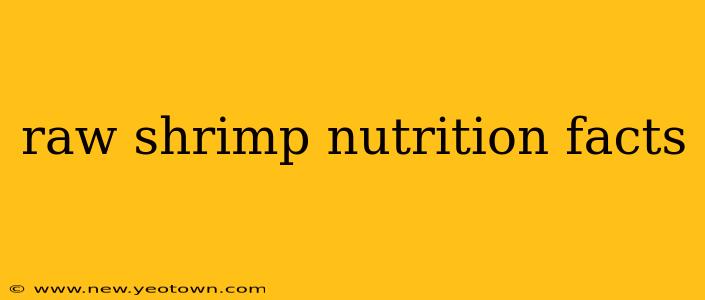Shrimp. The tiny crustacean that packs a mighty nutritional punch. From succulent scampi to spicy stir-fries, shrimp graces countless cuisines worldwide. But beyond its delicious versatility, lies a treasure trove of health benefits, all packed into its delicate, pink-hued flesh. Let's dive deep into the nutritional facts of raw shrimp and uncover why it deserves a prominent place in your diet.
What are the Nutritional Benefits of Raw Shrimp?
Raw shrimp is a lean protein powerhouse, boasting a surprisingly impressive nutritional profile. A 3-ounce serving of raw shrimp offers approximately:
- Protein: Around 20 grams – crucial for building and repairing tissues, making it a fantastic choice for athletes and those seeking muscle growth.
- Low in Fat: A surprisingly low-fat option, perfect for those watching their calorie intake. The fat it does contain is mostly unsaturated, the “good” kind of fat.
- Vitamins: A good source of several B vitamins, including B12 (essential for nerve function), niacin (supporting energy metabolism), and vitamin B6 (important for brain development and immune function). It also contains vitamin D, vital for calcium absorption and bone health.
- Minerals: Shrimp are rich in selenium, a powerful antioxidant that protects cells from damage. They are also a good source of zinc (boosting the immune system), iodine (supporting thyroid function), and phosphorus (essential for bone health and energy production).
- Cholesterol: While shrimp does contain cholesterol, the impact on blood cholesterol levels is often less significant than previously thought. This is because much of the cholesterol we consume is already processed by the liver. However, those with high cholesterol should still consume shrimp in moderation.
How Many Calories are in Raw Shrimp?
A 3-ounce serving of raw shrimp contains approximately 85 calories, making it a low-calorie, high-protein option for weight management. This makes it a popular choice for those looking to build lean muscle while keeping their calorie intake in check.
Is Raw Shrimp Good for Weight Loss?
Yes, raw shrimp can be a valuable part of a weight-loss diet. Its high protein content promotes satiety, meaning you feel fuller for longer, reducing overall calorie consumption. The low-fat content further contributes to its weight-loss-friendly profile. However, remember that weight loss is about overall diet and lifestyle, not just one food.
What are the Potential Risks of Eating Raw Shrimp?
While generally safe, consuming raw shrimp does carry some potential risks:
- Foodborne illnesses: Raw shrimp can harbor bacteria like Vibrio and Salmonella. Proper handling, thorough cooking (though we are focusing on raw here), and sourcing from reputable suppliers are crucial to minimize this risk. Always ensure your raw shrimp is kept extremely cold and consumed quickly after purchase.
- Allergies: Shrimp allergies are relatively common. Individuals with shellfish allergies should avoid consuming raw shrimp altogether.
Are There Different Types of Raw Shrimp, and Do They Vary in Nutrition?
Yes, there are various types of shrimp, including whiteleg shrimp, pink shrimp, and brown shrimp. Nutritional content can vary slightly depending on the species and its environment, but the overall nutritional profile remains largely consistent.
How to Choose and Prepare Raw Shrimp Safely?
Selecting and handling raw shrimp correctly is critical for food safety:
- Source: Buy shrimp from reputable seafood markets or grocery stores with known high standards of handling and storage.
- Appearance: Look for shrimp that are firm, have a translucent appearance, and smell fresh and slightly sweet, not fishy or ammonia-like.
- Storage: Keep raw shrimp refrigerated at or below 40°F (4°C) and consume it within 1-2 days of purchase.
This detailed look at the nutritional benefits and potential risks associated with consuming raw shrimp highlights its position as a valuable and versatile food. Remember to always prioritize safe handling and preparation to fully enjoy this delicious and nutritious seafood.

